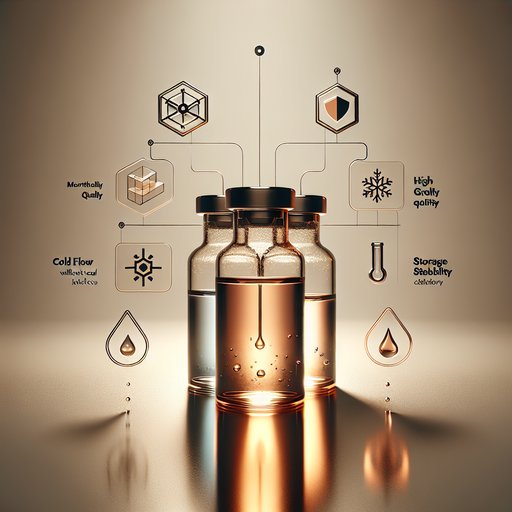
Fatty acid methyl esters (FAME, EN 14214) and hydrotreated vegetable oil (HVO, paraffinic diesel per EN 15940) both cut fossil carbon but behave very differently in engines and logistics. FAME is an oxygenated ester with good lubricity but limited cold flow and oxidative stability; HVO is a sulfur- and aromatic‑free paraffin with very high cetane, excellent cold performance, and strong storage stability but low density and lubricity. Blends with EN 590 diesel are common: B7–B10 for FAME and 10–100% for HVO. Understanding cetane, cold filter plugging, storage stability, and injector deposit control is crucial to avoid drivability issues and maintain aftertreatment durability.
The core distinction is chemistry: FAME consists of long‑chain methyl esters containing ~10–11 wt% oxygen; HVO is n‑/iso‑paraffinic hydrocarbons with virtually no heteroatoms. This drives ignition quality, cold flow, solvency, and stability. Typical cetane number (CN) for FAME meets ≥51 (EN 14214) and often lands 52–60 depending on feedstock (soy ~50–54, rapeseed ~52–58, tallow can be higher). HVO routinely achieves CN 70–90 (EN 15940 minimum 70).
LHV and density differ: FAME ~37.5 MJ/kg and 0.86–0.90 kg/L (~33 MJ/L), HVO ~44 MJ/kg and 0.77–0.79 kg/L (~34–35 MJ/L), vs EN 590 fossil diesel ~35.5–36 MJ/L. These properties translate to combustion and calibration effects. High‑CN HVO shortens ignition delay and reduces premixed heat release, typically lowering noise and NOx slightly while cutting soot. FAME’s oxygen content also suppresses soot but can nudge NOx up a few percent if calibration is unchanged.
On a mass basis, torque is preserved for both; on a volume basis, FAME and HVO may show 3–6% higher volumetric consumption than EN 590 due to lower MJ/L. Density differences also affect injection quantity in open‑loop regions; most modern ECUs compensate via fuel temperature/density maps, but legacy systems may show slight torque drift. Cold flow is a differentiator. FAME contains saturated mono/diglyceride traces that crystallize and drive cold soak filter plugging.
Summer‑grade FAME often exhibits CFPP around 0 to −5 °C (rapeseed/soy), with winterized or distilled grades reaching −10 to −20 °C; tallow‑based FAME can be +5 to +15 °C unless heavily treated. ASTM cold soak filtration time (CSFT) limits and monoglyceride controls (≤~0.7 wt% per EN 14214; tighter in some markets) are critical. HVO can be isomerized to tailor cold properties: standard grades achieve CFPP −20 to −30 °C, and “arctic” cuts reach ~−40 °C with cloud points aligned. Cold flow improvers help FAME modestly; in HVO, response is strong due to paraffinic crystallization behavior.
Storage stability diverges sharply. FAME is prone to oxidation and hydrolysis, forming peroxides, acids, and insolubles that foul filters and injectors. EN 14214 requires oxidation stability ≥8 h (Rancimat at 110 °C); retail EN 590 diesel with FAME typically targets ≥20 h using antioxidants. FAME also absorbs more water (hundreds to ~1,000+ mg/kg), increasing microbial risk; shelf life is best kept to months, in dry, opaque, cool tanks with periodic polishing, metal deactivators, and biocides as needed.
HVO shows excellent stability (Rancimat often >20–40 h), very low water solubility (<~100 mg/kg), and can store well for a year or more under normal housekeeping. Injector deposit control requires different tactics. FAME can carry residual metals (Na, K, Ca/Mg soaps), phosphorous, and monoglycerides that promote internal diesel injector deposits (IDID) and nozzle coking; tight control of contaminants (alkali/alkaline earth <5 mg/kg each; P <4–10 mg/kg), monoglycerides, and total glycerol is essential. Its higher solvency can keep legacy deposits mobile but may also transport gums formed during oxidation.
HVO’s very low aromatics and solvency reduce tip coking and soot but can increase IDID susceptibility if additive packages are poorly chosen; robust deposit control additives (detergent/dispersant 50–200 ppm active), demulsifiers, and metal deactivators mitigate this. For both fuels, keeping total insolubles low, ensuring water separation, and using OEM‑approved additive chemistries prevents amide/carboxylate‑type IDID. Field and DW10‑style engine tests show that properly additized HVO and well‑spec’d B7–B10 fuels maintain power loss within test limits. In practice, HVO offers very high ignition quality, excellent cold start/CFPP margins, strong storage stability, and low soot—beneficial for DPF load and injector cleanliness—but needs lubricity improver to meet wear scar targets and may slightly reduce volumetric fuel economy.
FAME supplies intrinsic lubricity and fossil CO2 reduction but demands disciplined cold‑weather grade selection, tight contaminant control, antioxidants/biocides, and shorter storage cycles. With correct specifications and additive systems, both can deliver reliable drivability and emissions compliance (Euro 6/7), though HVO generally carries higher cost while FAME imposes more supply‑chain housekeeping.












